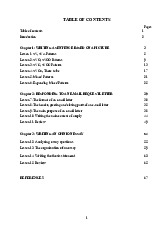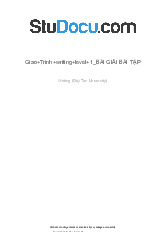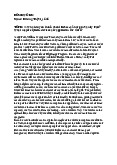



Preview text:
PRACTICE PART II. SHORT ANSWERS
Paraphrase each sentence using the word(s) given in brackets so that it means the same as the sentence provided.
1. They hold contrasting views of the issue. (different)
2. They are worried about their children’s safety. (concern)
3. The company laid off 100 staff due to Covid 19 pandemic. (fire)
4. The students made every effort to complete the test. (best)
5. The last time we paid a visit to this place was in 2020. (since)
6. The doctors agreed to perform an operation. (agreement)
7. Although Nam was very tired, he tried to finish his work. (however)
10. It is roughly estimated that some turtles lay 28 thousand eggs a year. (average)
11. The final version of the plan was quite different from the initial draft. (resemblance)
12. Rahul asked me, ‘Did you see the cricket match on TV last night?’ (if)
13. Many people fail to eat well and exercise, so they are unhealthy. (because)
14. We made an error with your account, but we have made every attempt to remedy it. (be)
15. Even though only about one‐tenth of the world’s population lives there, sub Saharan Africa remains ‐
the hardest hit region of illnesses. (but)
16. The proportion of people stating that they cycled to work to reduce pollution stood at 45%. (decrease)
17. It is necessary to control crime in the city as it hampers its growth. (need)
18. In spite of all our effort, we failed the competition. (though)
19. They left early because they didn’t want to get caught in the traffic. (so that)
20. She said, “I haven’t seen my parents since
last week.” (that)
21. To make up for the drops in profits, the company dismissed 30 workers last quarter. (fired)
22. Increasing health care costs imposes a heavy burden on patients. (expenses)
23. Candidates for the summer internship must submit their applications by June 30. (deadline) 1
24. Of the more than 1000 bicycling deaths each year, three-fourths are caused by head injuries. (reason)
25. At least one year of related experience is required for the position. (necessary)
26. Technology has benefitted the mankind in different ways. (benefits)
27. Improperly disposing of motor oil can pollute drinking water. (inappropriately)
28. One study concluded that wearing a bike helmet can reduce the risk of head injury by 85 percent. (conclusion)
29. There has been a dramatic rise in the production of films. (dramatically)
30. To make up for the drops in profits, the company fired 30 workers last quarter. (dismiss)
31. The best player got injured; thus, the team had no chance of winning the final. (because)
32. African Americans, who make up 13 percent of the U.S. population, accounted for 46
percent of the AIDS cases diagnosed in 1998. (however)
33. Tom said to Mary, “I am ready for my driving test, and I will take it tomorrow.” (told)
34. The engineers have renovated two luxurious guest suites on the building's 13th floor. (remodel)
35. Yearly pay raises will be determined after the employee evaluations. (assessed)
36. Successful applicants should speak a minimum of three languages. (fluency)
37. The building rental contract must be signed by both the tenant and the landlord. (agreement)
38. We are seeking those who have acquired broad experience in the service industry. (extensive) PART III. SHORT ESSAY
Read and summarize a text in your words. Text 1:
Online classes do not offer face-to-face interaction and they are more limited in their instruction
methods, yet they offer greater flexibility for scheduling.
The interaction between teachers and students in an online class is typically , meaning time-delayed that
students send an email and wait for a response. Interaction with classmates is less personal than it
would be in a traditional class because when student-to-student interaction is required, it is typically
limited to email or an online discussion board. The method of instruction in online classes is typically
limited to videos and reading articles that can be sent to students electronically. Many of the hands-on
experiences that students get in a traditional class are virtually impossible to have in an online class.
Rather than being able to touch and feel rocks in the geology class, students will be limited to videos or pictures of rocks.
On the other hand, the scheduling is very flexible. Students typically enroll in online classes because
they need the ability to take classes at night, early in the morning, or even during their lunch break at
work. The pace of online classes is typically determined by the students, so their personal and work
schedules do not need to be completely changed. While the interaction and instruction may be
limitations of an online class, the scheduling is very flexible. 2 Text 2:
Science has done wonders in present-day civilization. It has made human life easy and comfortable. In
ancient days man had to depend solely on the mercy of nature and in society manpower was the only
source for doing any laborious work. As time passed, man invented new appliances and applied new
techniques to do things in every walk of life. Man has now entered the atomic era. Today he has been
able to penetrate many of the mysteries of space. In some countries of the West, science has developed
human society to an unimaginable extent. We cannot manufacture today even a small needle without
having recourse to science. It saves both labor and time. Railways, trams, buses, ships, and aeroplanes
have made journeys easier and quicker. Again, radios, wireless, telephones, fax, television, and
computer help the spread of knowledge in no time. Science has worked miracles in the branch of
medicine, though its task is not yet complete. Text 3:
Since the world has become industrialized, there has been an increase in the number of animal species
that have either become extinct or have neared extinction. Bengal tigers, for instance, which once
roamed the jungles in vast numbers, now number only about 2,300, and by the year 2025 their
population is estimated to be down to zero. What is alarming about the case of the Bengal tiger is that
this extinction will have been caused almost entirely by poachers who, according to some sources, are
not interested in material gain but in personal gratification. This is an example of the callousness that is
part 10 of what is causing the problem of extinction. Animals like the Bengal tiger, as well as other
endangered species, are a valuable part of the world's ecosystem.
International laws protecting these animals must be enacted to ensure their survival, and the survival of our planet.
Countries around the world have begun to deal with the problem in various ways. Some countries, in
order to circumvent the problem, have allocated large amounts of land to animal reserves. They then
charge admission to help defray the costs of maintaining the parks and they often must also depend on
world organizations for support. With the money they get, they can invest in equipment and patrols to
protect the animals. Another solution that is an attempt to stem the tide of animal extinction is an
international boycott of products made from endangered species. This seems fairly effective, but it will
not, by itself, prevent animals from being hunted and killed. 3 Text 4:
You used to think that being green was a luxury for your company, but climate change has
made you realize that you can no longer ignore it. The buzz is about becoming carbon-neutral,
but where do you start? Consider your drivers. Do you want to become carbon-neutral for
marketing reasons, for financial reasons or to help save the planet? Simon Armitage of the
Carbon Neutral Company believes: “Your drivers will help you tailor your carbon-reduction
program and determine key performance indicators.” This will help build a case for going
carbon-neutral. First, measure your carbon footprint, or get a specialist to do it for you. That
primarily means taking account of your energy usage and emissions caused by travel. Before
you begin, think about whether you’re collecting the right data and whether it’s readily
accessible. When implementing any energy reduction measures, ensure you engage with your
staff. “It’s much better if your people decide for themselves when it’s sensible for them to
travel,” says Armitage. You’ll also need them to participate in switching off the lights and other
energy-saving measures. Set targets and show it’s not a one-off exercise. 4




